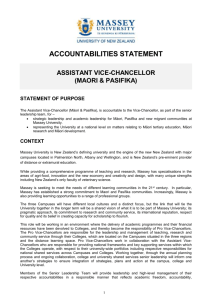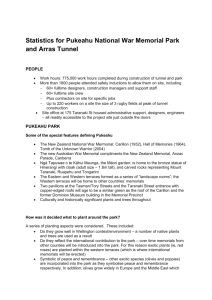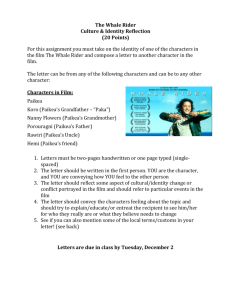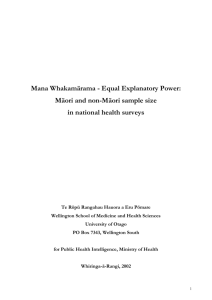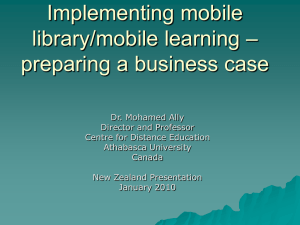Mäori & Public Health: Ethics
advertisement
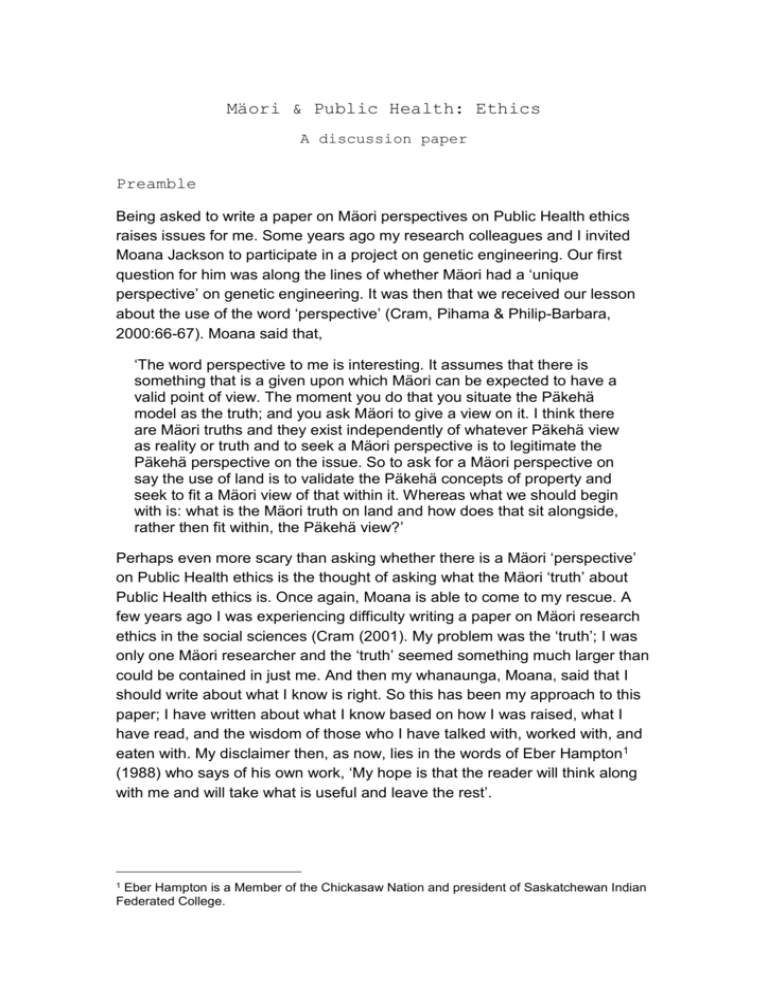
Mäori & Public Health: Ethics A discussion paper Preamble Being asked to write a paper on Mäori perspectives on Public Health ethics raises issues for me. Some years ago my research colleagues and I invited Moana Jackson to participate in a project on genetic engineering. Our first question for him was along the lines of whether Mäori had a ‘unique perspective’ on genetic engineering. It was then that we received our lesson about the use of the word ‘perspective’ (Cram, Pihama & Philip-Barbara, 2000:66-67). Moana said that, ‘The word perspective to me is interesting. It assumes that there is something that is a given upon which Mäori can be expected to have a valid point of view. The moment you do that you situate the Päkehä model as the truth; and you ask Mäori to give a view on it. I think there are Mäori truths and they exist independently of whatever Päkehä view as reality or truth and to seek a Mäori perspective is to legitimate the Päkehä perspective on the issue. So to ask for a Mäori perspective on say the use of land is to validate the Päkehä concepts of property and seek to fit a Mäori view of that within it. Whereas what we should begin with is: what is the Mäori truth on land and how does that sit alongside, rather then fit within, the Päkehä view?’ Perhaps even more scary than asking whether there is a Mäori ‘perspective’ on Public Health ethics is the thought of asking what the Mäori ‘truth’ about Public Health ethics is. Once again, Moana is able to come to my rescue. A few years ago I was experiencing difficulty writing a paper on Mäori research ethics in the social sciences (Cram (2001). My problem was the ‘truth’; I was only one Mäori researcher and the ‘truth’ seemed something much larger than could be contained in just me. And then my whanaunga, Moana, said that I should write about what I know is right. So this has been my approach to this paper; I have written about what I know based on how I was raised, what I have read, and the wisdom of those who I have talked with, worked with, and eaten with. My disclaimer then, as now, lies in the words of Eber Hampton1 (1988) who says of his own work, ‘My hope is that the reader will think along with me and will take what is useful and leave the rest’. 1 Eber Hampton is a Member of the Chickasaw Nation and president of Saskatchewan Indian Federated College. Mäori & Public Health: Ethics Fiona Cram August 2007 -2- Mäori & Public Health: Ethics Background The complicity of researchers and the policies and practices that research findings have justified in the colonisation of Aotearoa has been welldocumented in many theses, articles and books on Mäori, research, colonisation and ethics (for example, Linda Smith, 1999; Ngahuia Te Awekotuku, 1991). This situation is not unique to Aotearoa and to Mäori; across the globe indigenous peoples have protested about being overresearched by people who are alien to them and their communities, with the outcomes of this research too often being ‘misguided and harmful’ (Marlene Brant Castellano, 2004). Indigenous peoples are now justifiably both weary and wary of research and its outcomes (McNeill, Macklin, Wasunna & Komesaroff, 2005). Marlene Brant Castellano (2004:98), for example, describes the howls of protest and the scepticism from indigenous peoples in Canada during the 1992 Royal Commission on Aboriginal Peoples’ workshop to establish a research agenda. Like many workshops and hui in Aotearoa throughout the 1980s and 1990s2, and often even into the present day, people’s experiences of research gave them no reason to believe that it could serve their communities well. In Canada in 1992, the cry that they had been ‘researched to death’ was met by the quietly spoken words of an Elder; ‘If we have been researched to death, maybe it’s time we started researching ourselves back to life’. On this pathway ‘back to life’ indigenous peoples now ask and expect more of those who come to find out about, and possibly ‘do good’, for their communities. Some of the first responses to these expectations were made by non-indigenous researchers who embedded notions such as respect and cultural competence into their disciplinary codes of ethics (Te Awekotuku, 1991). Codes of good practice for indigenous research were also produced by agencies such as the Health Research Council of New Zealand and the World Health Organisation (HRC, 1998; WHO, 2003). Indigenous communities also produced their own codes of conduct for those wanting to work alongside them on research (e.g., Akwesasne Good Mind Research Protocol; Mi’kmaw Research Principals and Protocols). These codes speak of indigenous people’s rights to protect their culture and knowledge with these rights, in turn, underpinning the insistence of indigenous peoples that they are the arbiters of how they are researched and 2 Here I am speaking of my personal experience and those with longer memories may be able to extend this timeline further into our past. -3- Mäori & Public Health: Ethics represented. Only then can their cultural maintenance and revitalisation be assured (Brant Castellano, 2004). -4- Mäori & Public Health: Ethics Public Health Public health carries dual accountabilities of finding out and taking action. As Steven Coughlin (2006) notes, ‘Ethical concerns in Public Health often relate to the dual obligations of Public Health professionals to acquire and apply scientific knowledge aimed at restoring and protecting the public’s health while respecting individual autonomy’. Public health therefore begins with the acquisition and application of, in Coughlin’s view, ‘scientific knowledge’. If this knowledge does not represent the ‘truth’ about indigenous peoples then the restoration and protection of the Public Health of indigenous peoples is in jeopardy. Debates about the nature of knowledge and the search for truth so as to improve our conditions have raged since time immemorial and indigenous peoples are no strangers to the imposition of newcomers’ worldviews and knowledge validation claims (Caroline Kenny, Emily Faries, Jo-Anne Fiske & Cora Voyageur, 2004). For Mäori, the knowledge that has been built up around us by others is often about how we fall short of a norm that belongs to a worldview other than our own (Cram, 1997). We are seen for our deficits rather than our strengths; the things we need to change, rather than the things we need to build on. In 1968 Koro Dewes challenged this approach: I am sick and tired of hearing my people blamed for their educational and social shortcomings, their limitations highlighted and their obvious strengths of being privileged New Zealanders in being bilingual and bicultural ignored. The collision of worldviews highlighted in this quote needs to be confronted if the ‘acquisition and application’ of knowledge for the sake of the public’s health is going to be inclusive, rather than marginalising, of Mäori. We have our own knowledge systems that link us to this land; our own ways of acquiring knowledge and testing knowledge claims (Linda Smith, 1999). Sometimes these ways are sourced within tradition and other times we use ‘modern’ tools to explore issues that are important to us. Sometimes we choose to work alone and other times we choose to work collaboratively with non-Mäori. What is important here is that the choice is ours. The remainder of this paper explores Kaupapa Mäori theory and Kaupapa Mäori principles as they apply to Public Health. Over the past 10-15 Kaupapa Mäori theory has emerged as a guide for both Mäori and non-Mäori researchers who are committed to supporting Mäori struggles for control over our own cultural well-being and survival (cf. Graham Smith, 1997). It is therefore compatible with a Public Health agenda. -5- Mäori & Public Health: Ethics -6- Mäori & Public Health: Ethics Kaupapa Mäori Theory The term ‘Kaupapa Mäori’ emerged as part of our discourse in the late 1980s and 1990s in the theorising of a ‘by Mäori, for Mäori’ educational intervention; namely, Kura Kaupapa Mäori (Tuakana Nepe, 1991). Kaupapa Mäori is literally ‘a Mäori way’. Taki (1996:17) expands on this further in her consideration of the word ‘kaupapa’; namely that ‘kaupapa encapsulates…ground rules, customs, the right way of doing things’. ‘The term ‘theory’ has been deliberately co-opted by Smith and linked to ‘Kaupapa Mäori’ in order to develop a counter-hegemonic practice and to understand the cultural constraints exemplified within critical questions such as ‘what counts as theory?’ Smith challenges the narrow, eurocentric interpretation of ‘theory’…’ (Pihama, Cram & Walker, 2002). Graham Smith (1997) writes that Kaupapa Mäori theory is founded on three themes: taking for granted our right to be Mäori; ensuring the survival of the Mäori language and culture; and the central place occupied by our struggle to control our own cultural well-being. The challenge of Kaupapa Mäori theory is to reclaim New Zealand as Aotearoa, for Mäori and for whomever else wants to share this place on our terms. These terms are not difficult to locate as they are in the Mäori text of the Treaty of Waitangi. The guarantee of tino rangatiratanga is the affirmation of our sovereignty and our right to determine our own destiny. It is the guarantee of our right to be Mäori on our own terms. Graham Smith highlights six principles that are an integral part of Kaupapa Mäori theory: Tino Rangatiratanga (the ‘self-determination’ principle) taonga tuku iho (the ‘cultural aspirations’ principle) ako Mäori (the ‘culturally preferred pedagogy’ principle) kia piki ake i nga raruraru o te kainga (the ‘socio-economic’ mediation principle) whänau (the extended family structure principle) kaupapa (the ‘collective philosophy’ principle) Each of these is examined further with a view approaching Public Health ethics from a Mäori rights standpoint. -7- Mäori & Public Health: Ethics Tino Rangatiratanga (the ‘self-determination’ principle) The right of Mäori to sovereignty, or tino rangatiratanga, was affirmed in the Mäori language version of the Treaty of Waitangi, signed between Mäori chiefs and the colonial newcomers in 1840. Orange (1989:30) defines tino rangatiratanga within the context of the Treaty as ‘the unqualified exercise of their chieftainship over their lands, villages, and all their treasures’. In the English version, however, Mäori sovereignty is ceded (Kelsey, 1986). The 1975 Treaty of Waitangi Act established the Waitangi Tribunal to hear claims about breaches of the Treaty, and also required the Tribunal to give equal weights to both versions of the Treaty (Jackson, 2001). Thus Maori rights came to be seen with the context of the concerns of all New Zealanders. The right to self-determination is the most common theme in indigenous (and related) codes of ethics and declarations that affirm the rights of indigenous peoples. For example, the Indigenous Research Protection Act drafted by the Indigenous People’s Council on Biocolonialism begins with a statement about sovereignty: 1.1 The natural and cultural landscapes, including wildlife, flora, fauna, waters, and biogenetics, among others, located on aboriginal and present day Tribal lands are owned by the Tribe and the disposition, development, and utilization thereof are under the Tribe’s full control and supervision. In the Mataatua Declaration on Cultural and Intellectual Property Rights of Indigenous Peoples the following recommendations are made to States, National and International Agencies: 2.1 Recognise that indigenous peoples are the guardians of their customary knowledge and have the right to protect and control dissemination of that knowledge. 2.2 Recognise that indigenous peoples also have the right to create new knowledge based on cultural traditions. Self-determination is also one of the 45 principles of the United Nations’ Draft Declaration on the Rights of Indigenous Peoples. Any Public Health ethic must embody the Mäori right to self-determination. Taonga tuku iho (the ‘cultural aspirations’ principle) Kaupapa Mäori theory asserts the position that to be Mäori is valid, legitimate and normal. This requires a strengths-based approach to research and to interventions, rather than an approach that is deficit-based and victim-blaming as the latter is invariably based on research by ‘aliens’ to the Mäori world. -8- Mäori & Public Health: Ethics In her discussion of research projects that can decolonise indigenous peoples, Linda Smith (1999) pays tribute to indigenous calls for research methods that are more able to tell indigenous stories as a means of knowledge creation, healing and transformation. In Smith’s account, these methods are qualitative and range from testimony to envisioning. Kaupapa Mäori theory also creates space for the exploration and use of quantitative research tools. These tools include the use of epidemiology to monitor the Crown’s responsibilities to ensure good citizenship for Mäori (Robson, Purdie, Cram & Simmonds, 2007). In ethics guidelines this principle can be related to the principles of respect. At the same time, however, it should be noted that ‘respect’ itself is a culturallyembedded term such that respect might be offered from within one worldview but not received from within another worldview. An awareness of one’s own cultural standpoint/worldview and the acquisition of some cultural skills to negotiate the other’s world are therefore important if the collision of worlds is to be avoided. Ako Mäori (the ‘culturally preferred pedagogy’ principle) This principle promotes teaching and learning practices that are unique to Mäori culture. There is also an acknowledgment of ‘borrowed’ pedagogies and an emphasis on Mäori being able to choose our own preferred pedagogies. The development of ‘by Mäori, for Mäori’ health services and programmes is an expression of Ako Mäori. Such programmes and interventions are an expression of the need for providers to be culturally ‘in tune’ with Mäori. Ricks et al. (1999:xiii), for example, argue that in a system where the ‘dominant, professional, and ‘expert’ driven service delivery model and system’ predominates a service will contribute to compartmentalisation, firm attachment to the status quo, and a focus on deficit and pathology. On the other hand, a system underpinned by values of inclusion, collaboration, empowerment and integration will create personal and community capacity, trusting relationships, and be community driven. The latter scenario is akin to a Kaupapa Mäori approach whereas the former resonates of the criticisms of mainstream (lack of) responsiveness to Mäori. Kia piki ake i nga raruraru o te kainga (the ‘socio-economic’ mediation principle) This principle addresses the issue of Mäori socio-economic disadvantage and the negative pressures this brings to bear on whänau. While the cultural aspirations principle is about looking from the inside and exploring what it is to be Mäori, the socio-economic mediation principle is about an awareness of -9- Mäori & Public Health: Ethics structural issues that maintain Mäori marginalisation through the unequal distribution of resources. As Leonie Pihama (1993) argues, ‘…intrinsic to Kaupapa Mäori theory is an analysis of existing power structures and societal inequalities… exposing underlying assumptions that serve to conceal the power relations that exist within society’. The concept of 'cultural safety' also embodies reflexivity with respect to our own values, history, culture, etc. (Irihapeti Ramsden, 1988). Similarly, the broad concept of cultural competency proposed by Hazel Symonette (2004) encompasses the need to understand the ‘inside’ as normal while also having an analysis of the ‘outside’. According to Symonette, the first component of cultural competency, ‘Inside/Out’, requires people to develop an understanding of power and privilege hierarchies, including how they and those they are working with are located within these hierarchies. The second component, ‘Outside/In’, encompasses the development of ‘diversity-relevant knowledge and skills’. This principle also acknowledges that intervening successfully for the wellbeing of individuals and whänau must be sourced from Mäori realities. Whänau (the extended family structure principle) The whänau and the practice of whänaungatanga is an integral part of Mäori identity and culture. The cultural values, customs and practices which organise around the whänau and ‘collective responsibility’ are a necessary part of Mäori survival. This importance of whänau as a building block to Mäori well-being is emphasised in Ministry of Health strategic planning for Mäori health (Ministry of Health, 2002) and within Mäori models of health (Durie, 1994; Murchie, 1984; Pere, 1983). According to Mäori, te whänau-hapu is the heart of life for a person. It is the ground in which kinship and social relationship obligations and duties are learned, and enabled to flourish and flower (Henare, 1995 p.16). Issues of informed consent and privacy and confidentiality are often located within whänau and hapü. Decision-making about involvement in initiatives and the adoption of new ideas also occur at this collective level. This has implications for Public Health programmes and for health promotion activities. Kaupapa (the ‘collective philosophy’ principle) Kaupapa Mäori initiatives are held together by a collective commitment and a vision. This vision connects Mäori aspirations to political, social, economic and cultural wellbeing. - 10 - Mäori & Public Health: Ethics One element of this principle is the commitment to building the capacity of Mäori. Kaplan (1999:31) describes the goal of capacity building as the ‘…building of robust and sustainable organisations which are capable of sovereign focus and direction, of strategizing and innovation, of responding with flexibility and adaptability to changing circumstances, and of acting decisively to impact on, and change, their circumstances and social context’. The seventh principle of the Arctic Council Capacity Building Strategy (Arctic Council Capacity Building Strategy and Pilot Project, 2002:4) adds to this mainstream definition by stating that, ‘Capacity building should facilitate the evolution of indigenous culture in a way that enhances cultural integrity and identity. Cultural innovation and adaptability must be founded on cultural robustness and resilience’. - 11 - Mäori & Public Health: Ethics Concluding Remarks Kaupapa Mäori theory embodies the legitimation and validation of being Mäori; of being able to stand and to live within Aotearoa. In the words of Marlene Brant Castellano (2004:100), we are ‘talking about restoring order to daily living in conformity with ancient and enduring values that affirm life’. Within this Mäori–non-Mäori deficits are about the unequal distribution of social privilege and power. These, in turn, are sourced within broken Treaty promises and the denial of tino rangatiratanga. Kaupapa Mäori theory is therefore political merely by virtue of the challenge it poses to the status quo. If we are to fully regain our lives then this challenge is essential. Mason Durie (1998:214) describes Mäori health development as ‘a story of struggle, challenge, threat, adaptation, and adjustment’. The ‘good news’ is that Public Health’s commitment to equity and social justice means that it is well-placed to support and help facilitate Mäori aspirations for health and wellbeing. Public Health is no stranger to advocating for the marginalised and for social change. Kaupapa Mäori theory provides a set of rights-based principles that can ensure that this journey of support for Mäori is safe for all concerned. Mäori are also familiar with Public Health tensions between the upholding of individual rights and the need to protect public welfare. More discussion of how these decisions are made based on tikanga (Mäori cultural practices) may well add to the knowledge base and resources of Public Health. Finally, there are other values and practices that could have been discussed under the title of Mäori & Public Health: Ethics; for example, manaaki (respect, kindness), awhi (foster), and aroha (compassion), to name but a few. The interesting thing about the principles explored from Kaupapa Mäori theory is that they provide the space and the opportunity for those working on a Public Health initiative to come together to discuss the values that they want to bring to their work. When these discussions take place between insiders and outsiders (on whatever level), they are a means of crossing borders as people come together to define what it means to value and respect one another’s worldviews. - 12 - Mäori & Public Health: Ethics References Akwesasne Research Advisory Committee (1996). Akwesasne Good Mind Research Protocol. Akwesasne Notes, 2(1), Winter. Arctic Council Capacity Building Strategy and Pilot Project. Draft Report, March 28, 2002. (Retrieved 1 September 2004 from the Arctic Council website: www.arctic-council.org/files/oulu2002sao/11_5_1_cap_build.pdf ) Brant Castellano, M. (2004). Ethics of Aboriginal research. Journal of Aboriginal Health, January, 98-114. Coughlin, S.S. (2006). Ethical issues in epidemiological research and Public Health practice. Emerging Themes in Epidemiology, 3:16. This article is available from http://www.ete-online.com/content/3/1/16. Cram, F. (2001) Rangahau Maori: Tona Tika, Tona Pono. In M. Tolich (Ed.), Research Ethics in Aotearoa. Auckland: Longman. p.35-52. Cram, F. (1997). Developing partnerships in research: Mäori research and Päkehä researchers. SITES, 35, 44-63. Cram, F., Pihama, L & Philip-Barbara, G. (2000). Mäori and genetic engineering. A Research Report to Te Puni Kökiri, Wellington. 178pp. Dewes, K. (1968). Mäori education. In Report of The Young Mäori Leaders Conference. Department of University Extension, The University of Auckland. Durie, M.H. (1994). Whaiora: Mäori health development. Auckland: Oxford University Press. Durie, M. (1998). Whaiora. Auckland: Oxford University Press. Hampton, E. (1988). Towards a redefinition of American Indian/Alaska native education. Unpublished doctoral dissertation, Harvard Graduate School of Education. Health Research Council. (1998). Guidelines for Researchers on Health Research Involving Mäori. http://www.hrc.govt.nz/maoguide.htm Henare, M. (1995). Te Tiriti, te tangata, te whänau: the Treaty, the human person, the family. In Rights and responsibilities. Papers from the International Year of the Family Symposium on Rights and Responsibilities of the Family held in Wellington, 14 to 16 October 1994. Wellington: International Year of the Family Committee in association with the Office of the Commissioner for Children. - 13 - Mäori & Public Health: Ethics Jackson, M. (2001). Talk given at a Health Needs Assessment hui, Kuratini Marae, Wellington, 2 March 2001 (author’s notes). Kaplan, A. (1997). Capacity building: Shifting the paradigms of practice. Woodstock, South Africa: Community Development Resource Association. (Accessed 1 November 2006 from the Community Development Resource Association website at: http://www.cdra.org.za/articles/Capacity%20Building%20%20by%20Allan%20 Kaplan.htm) Kelsey, J. (1986). Te Tiriti o Waitangi and the Bill of Rights. Race, Gender, Class, 3, 23-30. Kenny, C., Faries, E., Fiske, J-A. & Voyageur, C. (2004). A holistic framework for Aboriginal policy research. Ontario: Status of Women Canada. McNeill, P.M., Macklin, R., Wasunna, A. & Komesaroff, P.A. (2005). An expanding vista: bioethics from Public Health, indigenous and feminist perspectives. Medical Journal of Australia, 183(1), 8-9. Mataatua Declaration on Cultural and Intellectual Property Rights of Indigenous Peoples (1993). Formulated at the First International Conference on the Cultural & Intellectual Property Rights of Indigenous Peoples, Whakatane, Aotearoa, 12-18 June 1993. (Retrieved 4 April 1999 from www.aotearoa.wellington.net.nz/imp/mata.htm) Mi’kmaw Research Principals and Protocols. (Downloaded 28 July 2004 from the Mi’kmaq College Institute website at http://mrc.uccb.ns.ca/prinpro.html) Ministry of Health (2002). He korowai oranga: Mäori health strategy. Wellington: Ministry of Health. Murchie, E. (1984). Rapuora: Health and Mäori women. Wellington: The Mäori Women’s Welfare League Inc. Orange, C. (1989). The story of a Treaty. Wellington: Bridget Williams Books. Pere, R. (1984). Te oranga o te whänau (The health of the family). In Hui Whakaoranga Mäori Health Planning Workshop. Hoani Waititi Marae March 19-22. Department of Health. Pihama, L.E. (1993). Tungia te ururua, kia tupu whakaritorito te tepu o te harakeke. MA thesis, The University of Auckland. Pihama, L., Cram, F. & Walker, S. (2002). Creating methodological space: A literature review of Kaupapa Mäori research. Canadian Journal of Native Education, 26, 30-43. - 14 - Mäori & Public Health: Ethics Ramsden, I. (1988). Kawa Whakaruruhau – Cultural Safety in nursing education in Aotearoa. Wellington: Ramsden. Ricks, F., Charlesworth, J., Bellefeuille, G. & Field, A. (1999). All together now: Creating a social capital mosaic. Victoria: Frances Ricks & Ottawa: Vanier Institute of the Family. Robson, B., Purdie, G., Cram, F. & Simmonds, S. (2007). Age standardisation – an indigenous standard? Emerging Themes in Epidemiology. An online journal published by BioMed Central. Available at http://www.eteonline.com/content/4/1/3. Smith, G. (1997). The development of Kaupapa Mäori: Theory and praxis. Unpublished Ph.D. Thesis, Education Department, University of Auckland. Smith, L.T. (1999). Decolonising methodologies: Research and indigenous peoples. New York: Zed Books & Dunedin: Otago University Press. Symontte, H. (2004). Walking pathways toward becoming a culturally competent evaluator: Boundaries, borderlands, and border crossings. New Directions for Evaluation, 102, 95-109. Te Awekotuku, N. (1991). He Tikanga Whakaaro: Research ethics in the Mäori community. Wellington:Manatu Mäori. World Health Organisation (2003). Indigenous peoples and participatory health research. Geneva: WHO Centre for Indigenous Peoples’ Nutrition and Environment. - 15 -
